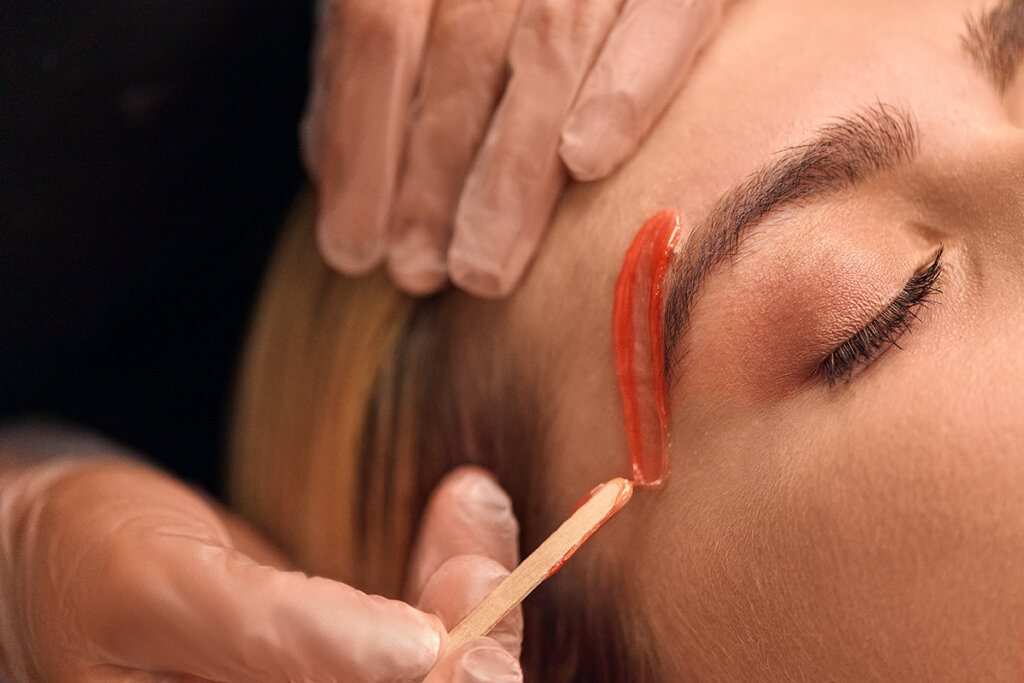If you have sensitive skin, you know that dealing with pesky skin flare-ups isn’t fun (to say the least). But these reactions are simply your body’s way of communicating with you, to let you know what it needs to feel — and look — its best.
If you’re prone to issues like dryness, redness, or uneven texture, your skincare routine might involve special products or have extra steps. Just like these helpful treatments, waxing helps you take care of your skin’s unique needs — and pamper yourself in the process. Waxing sensitive skin is one of the best ways to give your body the TLC it needs and deserves, revealing a smooth, soft, radiant glow. In this blog, we’ll guide you through everything you need to know about waxing for sensitive skin, including:
- Frequently asked questions about sensitive skin and waxing
- How services like bikini and Brazilian waxing affect your skin
- Best practices for waxing aftercare
Get the tea on these frequently asked questions about waxing sensitive skin
Can you wax sensitive skin?
Having sensitive skin often means having to be extra careful about products, sun exposure, and even spa or skin treatments. So, if you’ve ever wondered “can you wax sensitive skin?” or “is waxing bad for sensitive skin?” we’ve got you covered!
While your comfort level and personal skin needs are unique to you, we make waxing and sensitive skin go hand in hand with the right techniques and products. We do this by using custom-formulated waxes — one hard, one soft — that cater to all skin types, including sensitive skin. Our expert Cerologists are trained to prioritize your comfort by using pain-reducing application methods. Whether it’s redness, dryness, or irritation that you’re worried about, we’ve got your back (and brows, or bikini line).
Pro tip: If your skin sensitivity is severe (think: itchiness, cracking, dryness, rashes, or bumps), the first priority is to care for and heal it. This may mean talking with your doctor or dermatologist before beginning a treatment like waxing.

Is bikini waxing safe for sensitive skin?
The bikini area is naturally more delicate, which means some temporary irritation post-wax is normal. That said, sensitive skin can absolutely handle bikini waxing with a little extra prep and care. To ease this process and make bikini waxing more soothing for sensitive skin, it’s important to keep this area hydrated.
Our team can also apply a quick-healing mask after your bikini wax to help the process. This mask has anti-inflamatory and antibacterial properties for results that keep skin happy and smooth — a win-win for you and your skin!
Is Brazilian waxing safe for sensitive skin?
Much like bikini waxing, Brazilian waxing can also be safe for sensitive skin. But before jumping right in, deciding whether or not this treatment is right for you will depend on your level of skin sensitivity. It’s normal for skin to be extra sensitive in this area for 24–48 hours post-wax. This temporary irritation might include redness, itchiness, or bumps. If it lasts longer, talk to your Cerologist about your options.
Preparing your skin before a Brazilian wax and taking proper care of it afterward is the best way to minimize a reaction. And as always, if you’re unsure about whether Brazilian waxing is right for you, consult with your Cerologist or dermatologist.
Do I need to adjust my skincare routine after waxing?
Giving your skin a little extra love after waxing is a must, especially if it’s sensitive. Gentle exfoliation a few times a week can help prevent pesky ingrown hairs. Not sure where to start? Our well-loved sugar scrub is perfect for sensitive skin and pairs beautifully with our brushes, poufs, oils, serums, and more. During your appointment, your Cerologist can discuss your skincare needs and point you toward the products that are best for you. It’s also important to press pause on using any retinol products before AND after waxing.

What to know about sensitive skin and waxing before your first appointment
Feeling nervous about waxing sensitive skin for the first time? We’re here to make the process as smooth as possible. Here’s what to keep in mind:
Ask questions: Your Cerologist is your go-to expert! Let them know about any skin conditions or concerns you have.
Prep your skin: Avoid anything that might irritate your skin before your appointment, like heavy fragrances or tight clothing. You should also avoid using retinol before any waxing service. If your sensitive skin is already feeling irritated before the appointment, it’s best to reschedule and wait until the inflammation has gone away.
Expect some discomfort: Waxing isn’t pain-free, but a little ibuprofen beforehand can help take the edge off.
How to prepare for a wax when you have sensitive skin
To get your skin wax-ready, follow these steps:
- Exfoliate: Use a gentle scrub or mitt a few days before your appointment to slough off dead skin and reduce the risk of ingrown hairs.
- Protect: Avoid sun exposure in the 48 hours leading up to your appointment.
- Let it grow: For the best results, your hair should be about ¼ to ½ inch long — no shorter!

After waxing, give your sensitive skin extra TLC
Your skin deserves extra love after a waxing session, especially when it’s on the sensitive side. Mild irritation, like redness or bumps, is totally normal — but the right care can help your skin bounce back beautifully:
What to avoid: For the first 48 hours, skip anything that might aggravate or irritate your skin:
- Hot baths or showers
- Pools or standing water
- Heavy lotions or fragrances
- Sun exposure and tanning
What to do: Pamper yourself by wearing loose, breathable clothing, and use a gentle moisturizer designed for sensitive skin. Our Skin Revelation Calming Body Treatment works wonders to smooth and calm post-wax skin. Think of it as a relaxing facial for your body — hydrating even the driest areas for that radiant, silky glow.
Skin irritation after a wax treatment: What to look for
Remember, because waxing involves pulling hair out from the skin, agitation is normal following the treatment. But don’t worry — this typically goes away within two days. Keep an eye out for a rash, itching, irritation, bumps, or ingrown hairs (all of which can be expected). With a little extra self-care, self-love, and the advice above, you’ll be well on your way to feeling your best with smooth, radiant skin!
Get glowing with more advice from our experts
Want to keep your skin pampered and smooth all the time? We’ve got the scoop on all things skincare, beauty, and self care, so you can feel your best.


